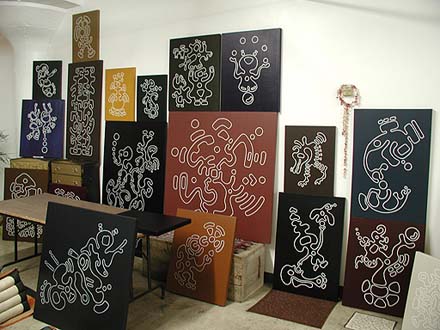A New Visual Language
Sara T. OninAn interview with visual artist Jason Tucker

Jason Tucker's studio. Click here to see more.
I first met Jason Tucker in the jungles of Uxmal, Mexico, at one of those week-long entheo-psycho-pharmacological symposiums. Following two mind-twisting back to back presentations by Jonathan Ott and the late Terence McKenna, I hit the poolside bamboo hut bar, where I saw Jason drawing. I too had my sketchbook along, so I sat down and introduced myself. Jason was from Los Angeles, like me. He had a slightly buried southern drawl, and like most Angelenos, was transplanted from elsewhere: San Angelo, Texas to be exact. Turned out we both worked professionally in the film and entertainment industry (he a film editor, me a storyboard artist) and we totally hit it off. Later, we stepped outside to watch the sun set, the sky slipping into early evening pinks and lavenders. The nearby Mayan ruins turned to dark silhouettes, the pyramid pointing up to unfamiliar constellations replacing the clouds above our heads. Then Jason started drawing. What came out on the paper was unlike anything I'd ever seen, yet at the same time, strangely familiar. It was futuristic. It was archaic. It was Visual Time Travel. And it was Weird.
Since then, Jason has spent a great deal of time exploring the dark reaches of inner space, creating well over 500 of these unusual drawings and paintings, each completed in one sitting. They've transformed from simple and decorative, reminiscent of Miro or Calder, to a more complex visual narrative, not unlike modern storytelling cave paintings. There are no plans and there are no mistakes. With no pre-set intention, his sessions seem more like a form of "auto-drawing," the images almost giving birth to themselves. He feels the pieces point toward an emotive visual language. During a studio visit to his downtown loft, the Los Angeles County Museum of Art (LACMA) echoed this idea in their newsletter, referring to the work as "an organic visual language evolving into a narrative." I once asked Jason if some shamanic entity from the past and/or future was guiding his hand to spell out messages or if perhaps he was some kind of universal cosmic radio station, broadcasting archetypal mysteries from another time and place. He just smiled slyly.
TRIP: So where did your style come from? How did this all start?
JASON TUCKER: I began drawing these abstract patterns of triangles, lines, and circles when I was young and it just evolved into something more cellular and figurative over the last seven years. I can remember resonating with a large abstract mosaic that was on this modern looking Methodist Church in my hometown. I can recall seeing it as a pattern of nature, just as organic as any pattern found on a leaf. The difference of course was the human connection. And I guess that struck a chord.
Did you think you would become an artist?
I actually consider the drawings to be more of a language than art, especially now that they have increased in volume and have taken on a more fluid, anthropomorphic form.
I see what you mean about language. When I first viewed your work I felt as though these self-creating beings were somehow speaking to me. Do you recall drawing much as a child?
I remember my mother would give me these drawing exercises, one of them being to draw what I thought God would look like. I drew this old man behind the clouds operating a rain and thunder machine. I can also remember in grade school not listening to the teacher while drawing straight lines over and over without a ruler, like I was practicing hand eye coordination or something. And then it developed into abstract patterns after that. I loved geometric shapes at the time, but I didn't care so much about perspective and rulers.
When did you become interested in the psychedelic experience?
My first encounter was with LSD and it was not based on any interest at all. I was out of town with my family attending a wedding and was staying in a hotel room with some family friends, who were a couple of years older than me. I was fourteen. One of them pulled out a tiny piece of paper with a blue UFO on it and cut it into three pieces. They handed me a third of that tiny piece of paper, I placed it on my tongue, and within the first hour I was in the bathroom sitting on top of the counter staring at my face in the mirror as it pulsated in ways that I'd never seen before. The whole room became more alive than I'd ever imagined it could be. What really struck me afterwards was how potent that tiny piece of paper was. I went to the wedding the next day and then back home and to school the next week. I returned to my regular routine and I never thought much about doing it again. Not until the summer after I graduated from college.
When and how did you end up in L.A.?
I headed out to Los Angeles about 12 years ago when I finished school in Boston. I wanted to work on films so it seemed like the natural thing to do.
And you've been drawing this whole time?
The drawings are always there, coming on stronger at certain times than others.
So these linear characters, these image entities, have been haunting you for awhile. Are you painting what you actually see?
Aside from one time on ayahuasca, I've never actually "seen" them. The moment didn't last long, but it was quite the hallucination. A couple of years before that, I drew something that was just as profound to me as any hallucination. It was another free form drawing like always, but it was no longer the abstract triangles and lines. It was cellular and completely alive. It had taken on a new form of communication. This opened the door to a flood of similar drawings and a fresh look at some of the ideas I've been interested in over the last twelve years. I certainly don't read Marshal McLuhan the same way, that's for sure.
How does Marshal McLuhan come into this?
McLuhan talked about how the modes of communication you use determine your reality. If you want to change your mind, change the mode of communication you use. And I find this to be extremely relevant to my experience. He also wrote about the possible moving away from fragmented thinking and towards a reintegration with the tribe and eventually a reintegration with something like the state we emerged from before the development of consciousness. I've read similar conclusions by Carl Jung. And McKenna has elaborated on it extensively. I see it as a synthesis of the modern and the archaic, and a union of spirit and instinct.
You spent time on occasion with Terence McKenna. Tell me about that.
In Mexico, I was drawing at a table with a group of people and he walked by and leaned over and watched for awhile. When I was finished I showed him some earlier drawings and explained I did some of them on DMT and that I saw it as an organic language. He raised his eyebrow and said it was a precarious enterprise, and that someone was bound to do it. McKenna was McLuhan on hallucinogens. He spoke of psilocybin invoking the Logos. He brought up how DMT works directly on the language centers of the brain. McKenna carried the torch of the irrational with pride and brought in serious talk of the Other, and differentiated between LSD's ties to enlightenment and DMT's potential to communicate with this Other, or possibly being the Other. Instead of highs and lows, it was becoming more of a trip sideways. The question was no longer about what is beyond the Milky Way, but what's behind it. McKenna was to inner space as Copernicus was to outer space. He theorized that consciousness appears to be heading into the non-linear, and he raised controversial topics like downloading human consciousness, time travel, new languages, and alien contact. As a film editor, I relate just by the tools I use. Now, editing is done on the computer. We digitize information from a linear source tape into software that allows us to edit nonlinearly. I see the ideas of McLuhan and McKenna as connected to the electric age just like the ideas of Freud and Jung are connected to the industrial.
Where do you think you'll go with this from here?
Well, I'm in the process of animating them right now. If you've ever seen the splitting of cells as well as the dynamics of cell formation, it's easy to visualize these images slowly moving and morphing into one another.
Jason Tucker is currently working as an animation editor in Los Angeles. His images can be seen on his web site: http://www.actualcontact.com.
Tags : psychedelic
Rating : Teen - Drugs
Posted on: 2004-04-08 00:00:00
|


